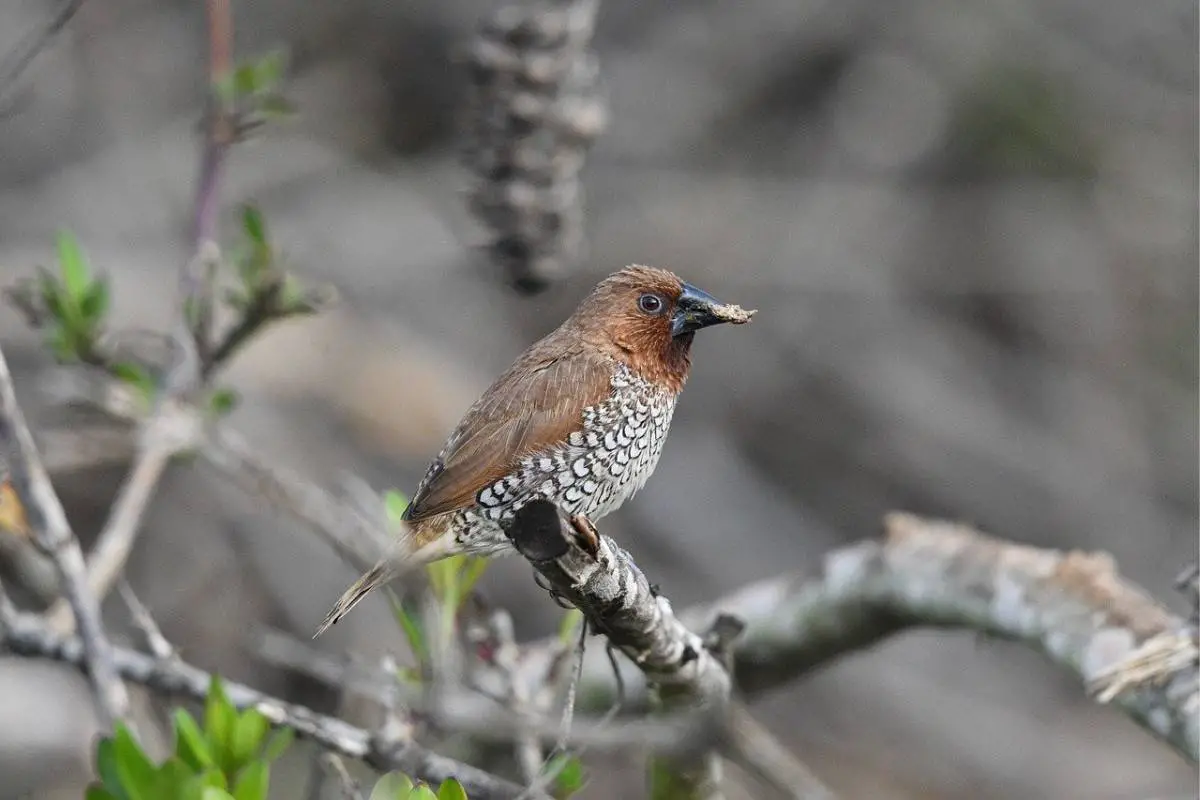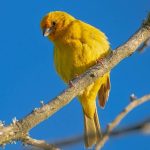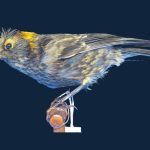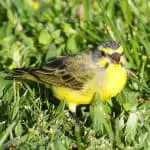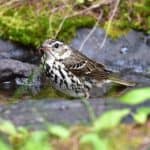Common Name: Scaly-breasted Munia
Scientific Name: (Lonchura punctulata)| Size | Diet | Range in Hawaii | Status in Hawaii |
|---|---|---|---|
| 4 in. - 5 in. | seeds and grains | Common on all islands | Least Concern |
The Scaly-breasted Munia, also known as the Spotted Munia, is a small bird species that is native to tropical Asia. However, it has also been introduced to other parts of the world, including Hawaii, where it has become a naturalized resident. Despite being a non-native species, the Scaly-breasted Munia has been long established in Hawaii, and can be found in a variety of habitats on the islands.
In this article, we will explore more about the Scaly-breasted Munia, its unique characteristics, and its presence in Hawaii.
Scaly-breasted
Appearance

The Scaly-breasted Munia is a small bird with a distinctive appearance. It has a compact body and measures approximately 4 to 5 inches in length.
The plumage of the Scaly-breasted Munia is predominantly brown with a scaly pattern on its breast, giving it its name. The feathers on its back and wings are darker brown, while the belly and throat are lighter in color.
It has a short, thick bill and dark eyes. Both males and females have similar appearances, making it difficult to distinguish between the sexes based on visual characteristics alone.
Diet
The diet of the Scaly-breasted Munia primarily consists of seeds and grains. It is highly adapted to feeding on grass seeds, which makes up a significant portion of its diet. It is known to forage in open habitats such as rice fields, grassy fields, and agricultural areas where it can find an abundance of seeds.
The bird uses its short, stout bill to crack open the seeds and extract the nutritious kernels. In addition to grass seeds, the Scaly-breasted Munia may also feed on other small seeds, including those from weeds and cultivated crops.
While seeds form the mainstay of its diet, this species may also consume small insects and their larvae occasionally, especially during the breeding season when protein-rich food is crucial for raising chicks.
Nesting
The Scaly-breasted Munia constructs its nests in a unique and intricate manner. The nests are typically spherical in shape and are built using various materials such as fine grasses, plant fibers, and sometimes even spider webs. These materials are skillfully woven together to create a sturdy structure with a small side entrance.
The nesting sites chosen by Scaly-breasted Munias are diverse and can include locations such as shrubs, tall grasses, or even man-made structures like buildings or bridges. They display adaptability in their choice of nesting sites, often selecting areas that provide suitable cover and protection from predators.
The female Scaly-breasted Munia takes the primary responsibility for nest construction, while the male may assist by bringing additional nesting materials. Inside the nest, a cup-shaped depression is created, where the female lays and incubates the eggs. The clutch typically consists of four to six eggs, which are pale white and speckled with brown or gray markings.
Both parents participate in incubating the eggs and caring for the hatchlings. After a period of incubation, which lasts around 12 to 14 days, the eggs hatch, and the parents take turns feeding the nestlings a diet consisting mainly of seeds. The young birds remain in the nest for approximately two to three weeks until they fledge and become independent.
The Scaly-breasted Munia exhibits cooperative breeding behavior, with additional adult “helpers” sometimes assisting in raising the offspring. This cooperative breeding system helps in protecting the nest and ensuring the survival of the young birds.
Behavior
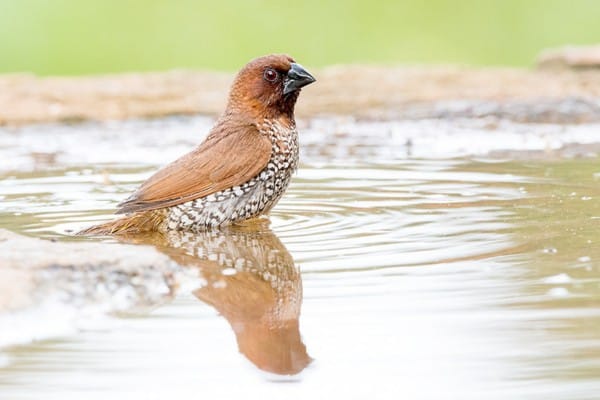
The Scaly-breasted Munia displays several interesting behaviors that contribute to its survival and interaction with its environment. These behaviors include foraging, flocking, and courtship displays.
When it comes to foraging, the Scaly-breasted Munia is primarily a seed-eater. It is often observed feeding on grass seeds and can be found in open habitats such as rice fields, grassy fields, and agricultural areas.
The bird uses its short, stout bill to crack open seeds and extract the edible kernels. While seeds form the main part of its diet, it may also consume small insects and their larvae, particularly during the breeding season.
One notable behavior of the Scaly-breasted Munia is its tendency to form large flocks. These flocks can consist of numerous individuals and are often seen foraging or roosting together.
This behavior provides protection against predators and allows the birds to locate food more efficiently. Flocking behavior also facilitates social interaction and communication within the group.
During the breeding season, the Scaly-breasted Munia engages in courtship displays. These displays involve various behaviors such as wing flicking, bowing, and vocalizations. Males may also perform elaborate flights or chase each other as part of their courtship rituals. These displays are used to attract mates and establish breeding territories.
Cooperative breeding is another notable behavior of the Scaly-breasted Munia. In some cases, additional adult “helpers” may assist in raising the offspring. These helpers contribute to nest defense, feeding the young, and overall parental care. This cooperative breeding system increases the chances of survival for the nestlings and demonstrates social behavior within the species.
Habitat
The Scaly-breasted Munia is a bird species that exhibits adaptability to a range of habitats. It is commonly found in lowland fields, open woodlands, grassy areas, and parks.
The bird is particularly associated with habitats that provide an abundance of seeds, such as grass seeds. This includes areas like rice fields, agricultural fields, and areas with dense vegetation.
While the Scaly-breasted Munia is primarily found in open habitats, it can also be observed in the vicinity of native forests. It occasionally ventures into openings and edges of native forest habitats, although it is not considered a forest-dwelling species.
Range
The Scaly-breasted Munia, a bird species native to India and Southeast Asia, has successfully established populations on several islands in Hawaii. It can be found on Kaua’i, O’ahu, Moloka’i, Maui, Hawai’i (the Big Island), Lana’i, Kaho’olawe, Ni’ihau, Lehua Islet, and Kaula Rock.
This widespread distribution across multiple islands demonstrates the adaptability and successful colonization of the Scaly-breasted Munia in various habitats within the Hawaiian archipelago.
Conservation Status

The conservation status of the Scaly-breasted Munia is currently assessed as a species of “Least Concern” by the International Union for Conservation of Nature (IUCN). This designation indicates that the population of the Scaly-breasted Munia is relatively stable, and it does not face immediate threats that would significantly impact its survival.
Although there may be local declines or fluctuations in populations due to factors such as habitat loss or competition with other species, the species as a whole is not considered to be at high risk of extinction.
Interesting Facts
1. Elaborate courtship displays
Males perform intricate displays involving wing flicking, bowing, and vocalizations.
2. Flocking behavior
Forms large flocks for protection and efficient foraging.
3. Variable plumage
Although the overall appearance of males and females is similar, the intensity of the scaly pattern on their breast can vary, with some individuals showing more prominent scales than others.
4. Rapid nest construction
The Scaly-breasted Munia is known for its quick nest-building abilities, often completing nests within a short period.
5. Versatile nests
Besides building nests in shrubs and grasses, they can also utilize man-made structures such as buildings or bridges for nesting.
Frequently Asked Questions
1. Are Scaly-breasted Munias considered invasive species?
Yes, Scaly-breasted Munias are classified as invasive species in some regions due to their successful establishment and potential impact on native ecosystems.
2. How long do Scaly-breasted Munias live?
On average, Scaly-breasted Munias have a lifespan of about 4 to 7 years in the wild. However, with proper care in captivity, they can live up to 10 years or more.
3. Are Scaly-breasted Munias good singers?
While not known for their singing abilities, Scaly-breasted Munias produce various vocalizations, including calls and chirps, to communicate with each other and during courtship displays.
